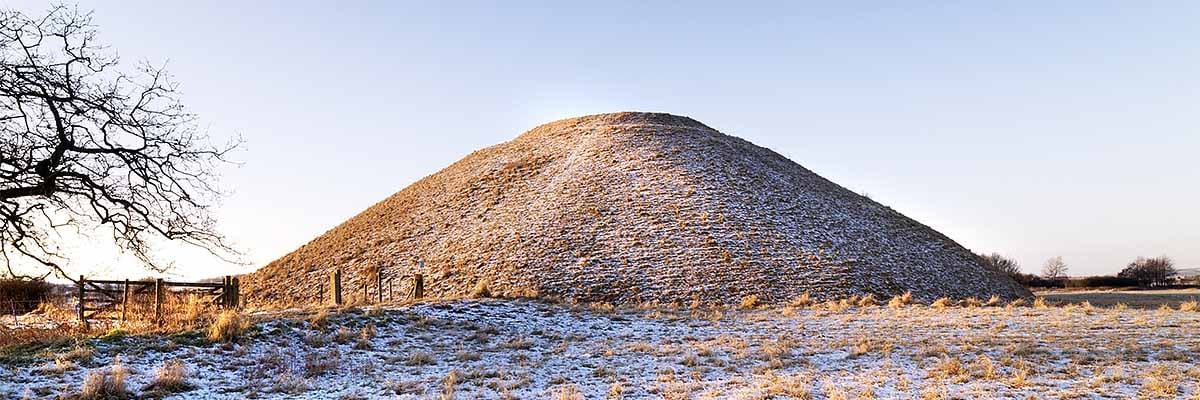History of Silbury Hill
Silbury Hill is the largest artificial prehistoric mound in Europe. Probably built over a short period between about 2470 and 2350 BC, it is one of the most intriguing monuments in the prehistoric landscape of the Avebury World Heritage Site. We do not know its purpose, or its meaning for the late Neolithic people who built it, but its enduring presence in the landscape has inspired myths and legends as people have sought to explain its purpose.

Origins and Construction
Silbury Hill stands 30 metres high and 160 metres wide, and its construction is estimated to have involved about 4 million man hours of work. Half a million tonnes of material, mostly chalk, were used to create it.
The monument we see today was not conceived and built in a single campaign, but enlarged over several generations. Perhaps different people brought soil and chalk from their own neighbouring lands, bringing communities together. Over time, the project became more ambitious, with huge quantities of chalk dug from the surrounding ditch to build the mound.
First, people stripped the topsoil and stones from the ground. Then a small mound of gravel a little less than 1 metre high was built, with material perhaps brought from the nearby river Kennet.
At some later stage, a ring of stakes was set out to define a larger area, 16 metres in diameter, into which basketloads of mud and dark soils were tipped. Smaller heaps were constructed nearby and some pits, probably relating to ceremonial activity, were dug into the central mound.
People continued to add soil and turf and even boulders, creating a mound 35 metres in diameter and about 5 metres high. A massive enclosing ditch with an internal bank was then dug, 100 metres in diameter. It was backfilled and re-cut a number of times.
A series of chalk banks were added to the mound, increasing its size and back-filling the ditch. A second enormous water-filled ditch and rectangular extension were dug beyond it, leaving space for the chalk mound to be further enlarged.
The Neolithic Landscape
No one knows why Silbury Hill was built, but we do know that it was during a time of great change, when new forms of pottery, new burial rites and the first metal-working arrived in Britain. It must have been a special place, where people gathered for events and episodes of building.
This period saw intense building activity in the Avebury area, when hundreds of people came together to construct a variety of monuments. As well as Silbury Hill, Avebury henge, together with its stone circles and avenues, was built at this time. Two large oval enclosures at West Kennet were also built out of massive timber posts, which now only survive as buried remains.
These monuments, including Silbury Hill, now form the core of the Avebury World Heritage Site.
Roman and Medieval Use
The story of Silbury Hill does not end in prehistory. A recent geophysical survey has shown that the Romans chose to build a road and an extensive settlement around the foot of the mound.
In the early medieval period, the top of the hill was probably flattened and some sort of defensive structure may have been placed on the summit.
An Unfortunate Legacy
This intriguing mound has long been an archaeological enigma. No doubt spurred on by stories of rich burials, antiquarians and archaeologists have dug at least three separate tunnels into the centre.
In 1776 Hugh Percy, Duke of Northumberland, financially supported an excavation by Edward Drax, who directed a group of miners to dig a vertical shaft from the summit to the centre of the hill. They failed to find the central burial they had expected.
Later, in 1849, John Merewether, the dean of Hereford, oversaw the excavation of a horizontal tunnel into hill. Again, no central burial was discovered but organic remains including decayed moss and turf were found.
Professor Richard Atkinson led a third major investigation between 1968 and 1970. Sponsored by the BBC, it was the first excavation to be televised as it progressed. Atkinson excavated another tunnel on a similar line to Merewether’s and identified three phases of construction.
Not one of these tunnels was fully backfilled, leaving an unfortunate legacy. In May 2000 the full consequence of this was made clear when a 14-metre deep crater opened on the summit. Further survey showed that the tunnels inside were collapsing. The crater was temporarily filled with polystyrene, but clearly something more permanent had to be done to stabilise the hill.
The collapse prompted a new phase of research on the hill, including various forms of non-invasive survey, seismic survey and limited excavation.
FIND OUT MORE ABOUT SILBURY HILL
